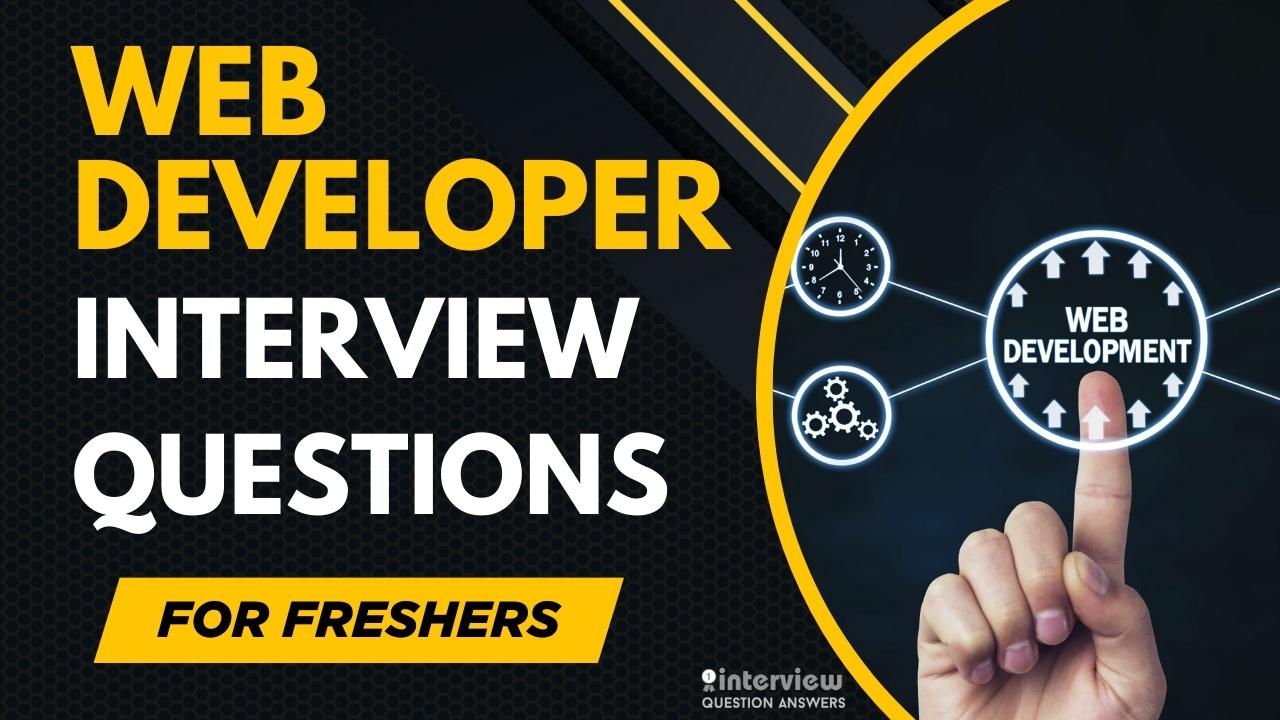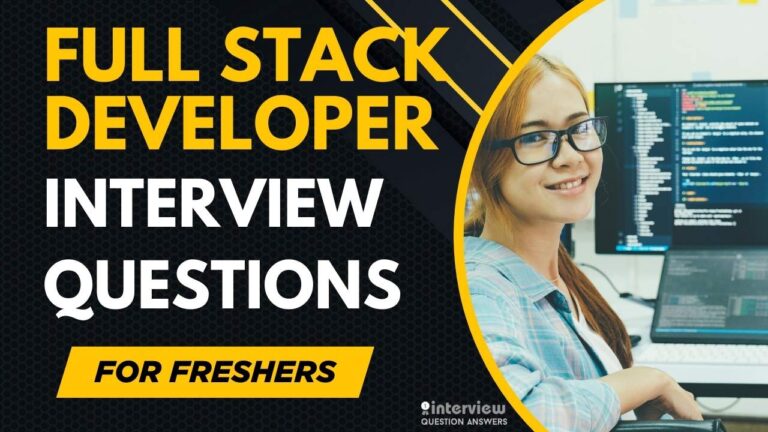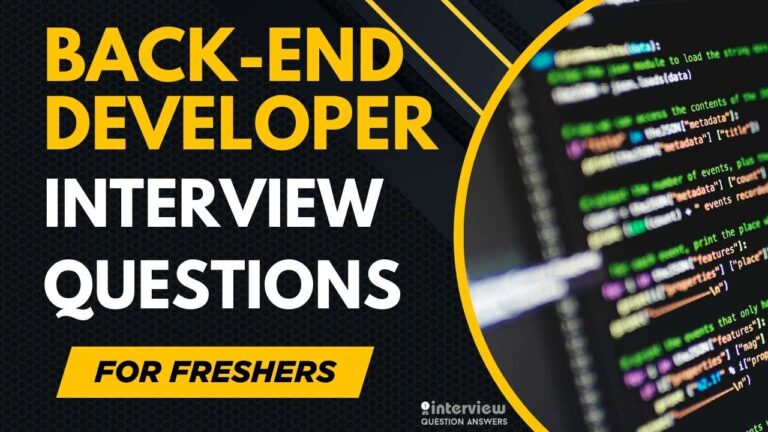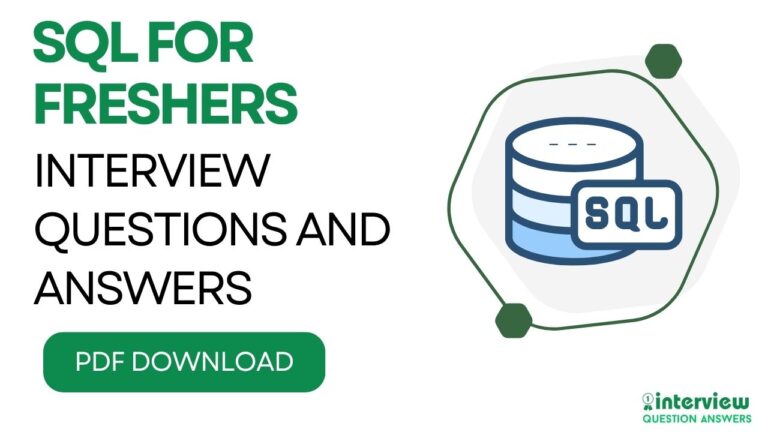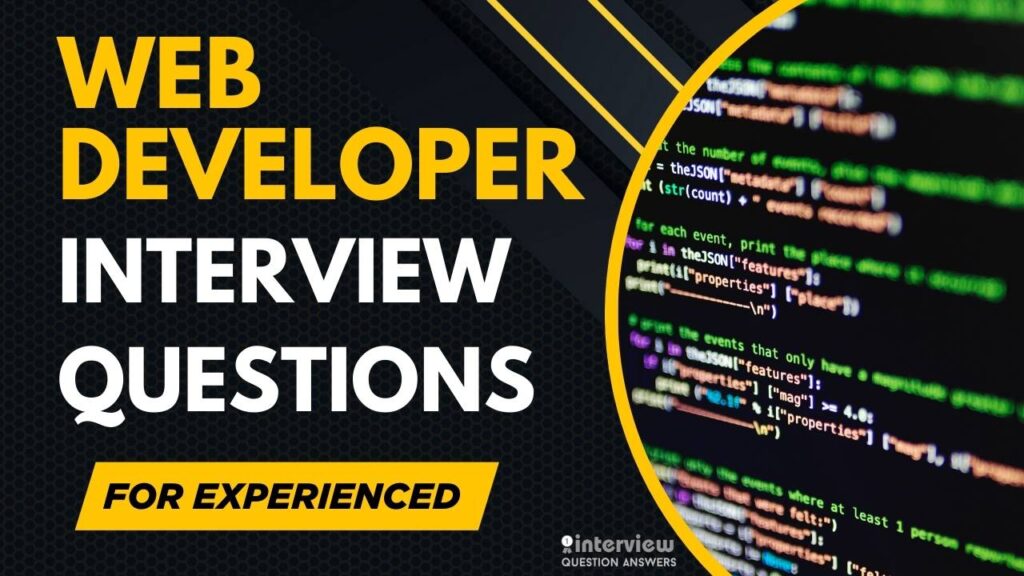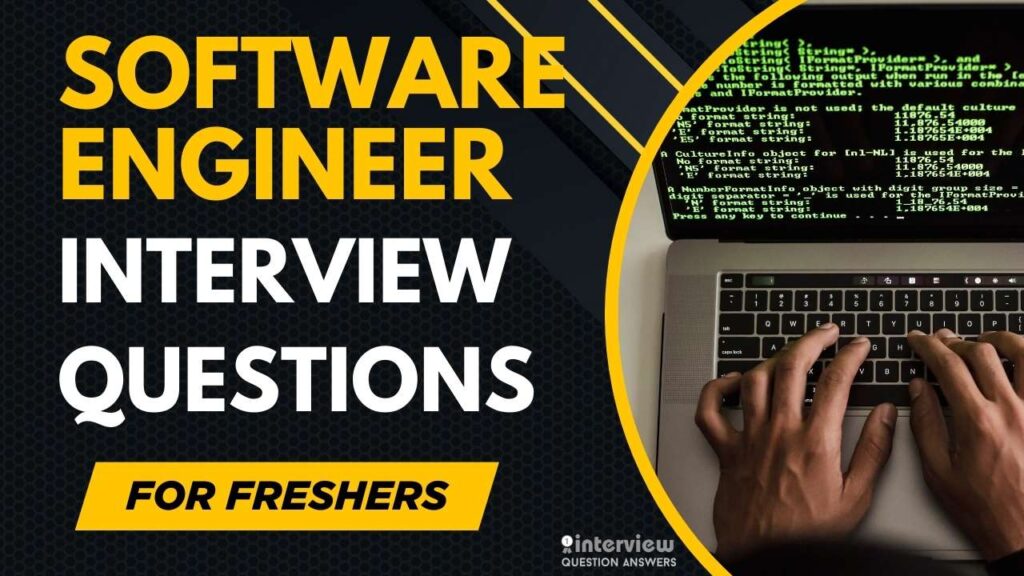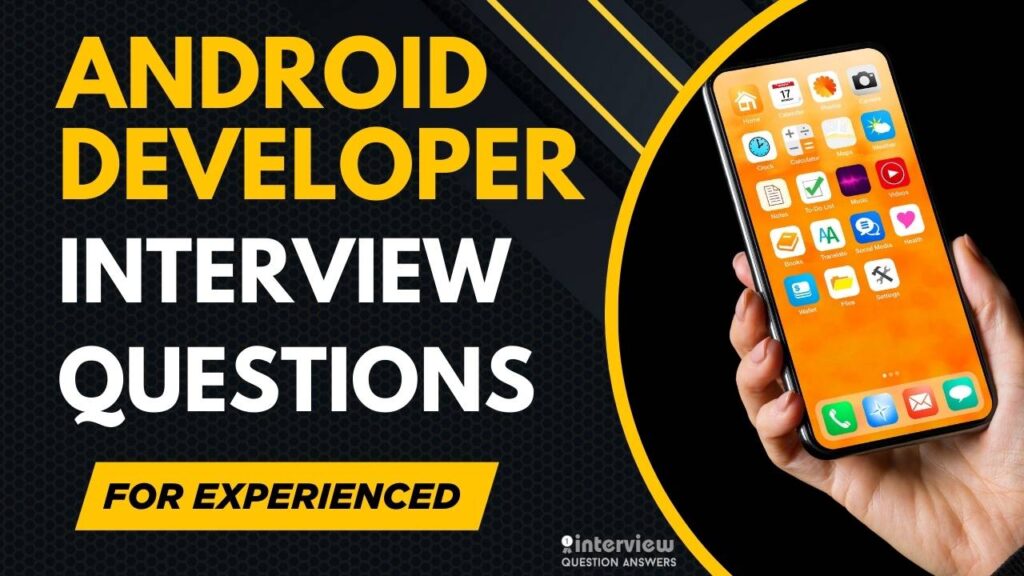Top 60 Web Developer Interview Questions for Freshers
Are you planning to start your career as a web developer and preparing for interviews? Our Web Developer Interview Questions for Freshers guide gives you a complete collection of basic and advanced questions to help you build strong foundational knowledge and gain the confidence to crack interviews.
This guide helps you learn core web development concepts like HTML, CSS, JavaScript, and DOM manipulation while also introducing you to responsive design, web performance optimization, version control with Git, and beginner-level backend concepts. It covers both conceptual and practical questions so you can understand the real-world applications of your skills.
With businesses shifting rapidly toward digital transformation and expecting developers to be familiar with modern frameworks, APIs, and deployment practices, freshers with a strong understanding of front-end basics, backend fundamentals, and problem-solving skills stand out from the competition. Whether you want to become a front-end, back-end, or full-stack developer, this guide sets the right foundation for your interview preparation.
You can also check our another detailed guide: Web Development Interview Questions PDF
Table of Contents
Entry Level Web Developer Interview Questions
Que 1. What is HTML, and why is it important for web development?
Answer:
HTML (HyperText Markup Language) is the standard language for creating web pages, defining their structure and content using elements like <div>, <p>, and <a>. It’s the foundation of web development, enabling browsers to render content.
Que 2. What is the difference between HTML and CSS?
Answer:
HTML provides the structure of a webpage, while CSS (Cascading Style Sheets) controls its appearance, such as colors, fonts, and layouts.
<!-- HTML -->
<div class="box">Hello</div>
<!-- CSS -->
<style>
.box { background-color: blue; color: white; }
</style>Que 3. What is JavaScript, and what role does it play in web development?
Answer:
JavaScript is a programming language that adds interactivity to web pages, such as dynamic content updates, form validation, and event handling. It runs in the browser and manipulates the DOM.
document.getElementById("myButton").addEventListener("click", () => {
alert("Button clicked!");
});Que 4. What is the DOM, and how does it work?
Answer:
The Document Object Model (DOM) is a tree-like representation of a webpage’s HTML structure. JavaScript interacts with the DOM to dynamically update content, styles, or structure.
Que 5. How do you create a responsive webpage?
Answer:
Use CSS techniques like relative units (vw, vh, rem, em), media queries, and frameworks like Bootstrap to adapt layouts to different screen sizes.
@media (max-width: 600px) {
.container { width: 100%; }
}Que 6. What is the purpose of the tag in HTML?
Answer:
The <meta> tag provides metadata about the webpage, such as character encoding, viewport settings, or SEO information, which browsers and search engines use.
<meta name="viewport" content="width=device-width, initial-scale=1.0">Que 7. How do you include external CSS in an HTML file?
Answer:
Use the <link> tag in the <head> section to include an external CSS file.
<link rel="stylesheet" href="styles.css">Que 8. What is the difference between id and class in HTML?
Answer:
An id is a unique identifier for a single element, while a class can be applied to multiple elements for shared styling.
<div id="unique" class="shared">Content</div>Que 9. How do you handle events in JavaScript?
Answer:
Use addEventListener to attach event handlers to DOM elements for actions like clicks or keypresses.
document.querySelector(".btn").addEventListener("click", () => {
console.log("Clicked!");
});Que 10. What is the purpose of the box-sizing property in CSS?
Answer:
The box-sizing property defines how an element’s width and height are calculated. border-box includes padding and border in the size, while content-box does not.
.box {
box-sizing: border-box;
width: 100px;
padding: 10px;
}Que 11. How do you center a div horizontally and vertically in CSS?
Answer:
Use Flexbox or CSS Grid to center a div both horizontally and vertically.
.container {
display: flex;
justify-content: center;
align-items: center;
height: 100vh;
}Que 12. What is the difference between relative and absolute positioning in CSS?
Answer:position: relative moves an element relative to its original position, while position: absolute positions it relative to its nearest positioned ancestor or the document.
.relative { position: relative; top: 10px; }
.absolute { position: absolute; top: 10px; left: 10px; }Que 13. How do you make an HTTP request in JavaScript?
Answer:
Use the fetch API to make HTTP requests and handle responses asynchronously with promises or async/await.
fetch('https://api.example.com/data')
.then(response => response.json())
.then(data => console.log(data));Que 14. What is the purpose of the alt attribute in an tag?
Answer:
The alt attribute provides alternative text for an image, used by screen readers for accessibility and displayed if the image fails to load.
<img src="image.jpg" alt="Description of image">Que 15. How do you create a simple form in HTML?
Answer:
Use the <form> element with inputs like <input>, <textarea>, and <button> to create a form.
<form action="/submit" method="POST">
<input type="text" name="username" placeholder="Username">
<button type="submit">Submit</button>
</form>Que 16. What is the difference between let, const, and var in JavaScript?
Answer:let allows block-scoped variable reassignment, const is block-scoped but immutable, and var is function-scoped with hoisting, often causing issues.
let x = 1; // Reassignable
const y = 2; // Immutable
var z = 3; // Function-scopedQue 17. How do you add comments in HTML, CSS, and JavaScript?
Answer:
Use specific syntax for each language to add comments.
<!-- HTML comment -->
<style>
/* CSS comment */
</style>
<script>
// JavaScript single-line comment
/* JavaScript multi-line comment */
</script>Que 18. What is the purpose of media queries in CSS?
Answer:
Media queries apply styles based on conditions like screen size or device type, enabling responsive design.
@media (min-width: 768px) {
.container { font-size: 18px; }
}Que 19. How do you debug JavaScript code in the browser?
Answer:
Use browser developer tools (e.g., Chrome DevTools) to set breakpoints, inspect variables, and view console logs with console.log().
console.log('Debugging:', variable);Que 20. What is the difference between inline, block, and inline-block in CSS?
Answer:inline elements (e.g., <span>) flow within text without breaking lines. block elements (e.g., <div>) take full width and start on a new line. inline-block allows inline flow with block-level properties like width and height.
.inline { display: inline; }
.block { display: block; }
.inline-block { display: inline-block; width: 100px; }
Also Check: Web Developer Interview Questions for Experienced
Basic Web Developer Interview Questions for Freshers
Que 21. What is the purpose of the <Head> tag in HTML?
Answer:
The <head> tag contains metadata about the webpage, such as the title, character encoding, links to CSS/JavaScript files, and meta tags for SEO or viewport settings. It doesn’t display content directly.
<head>
<title>My Page</title>
<meta charset="UTF-8">
<link rel="stylesheet" href="styles.css">
</head>Que 22. How do you link an external JavaScript file to an HTML document?
Answer:
Use the <script> tag with the src attribute in the <head> or at the end of the <body> to include an external JavaScript file.
<script src="script.js"></script>Que 23. What is the difference between <Div> and <Section> in HTML?
Answer:
A <div> is a generic container for grouping content without semantic meaning. A <section> is a semantic element representing a standalone section of related content, improving accessibility and SEO.
<section>
<h2>Section Title</h2>
<div>Content block</div>
</section>Que 24. How do you style a button using CSS?
Answer:
Use CSS properties like background-color, padding, border, and font-size to style a button, often with :hover for interactivity.
button {
background-color: #007bff;
color: white;
padding: 10px 20px;
border: none;
border-radius: 5px;
}
button:hover {
background-color: #0056b3;
}Que 25. What is the purpose of the z-index property in CSS?
Answer:
The z-index property controls the stacking order of positioned elements. Higher values place elements above those with lower values.
.element {
position: absolute;
z-index: 10;
}Que 26. How do you create a hyperlink in HTML?
Answer:
Use the <a> tag with the href attribute to create a hyperlink to another page or resource.
<a href="https://example.com">Visit Example</a>Que 27. What is the difference between GET and POST methods in HTML forms?
Answer:GET appends form data to the URL as query parameters and is used for retrieving data. POST sends data in the request body, suitable for sensitive or large data.
<form method="GET" action="/search">
<input type="text" name="query">
</form>
<form method="POST" action="/submit">
<input type="text" name="username">
</form>Que 28. How do you select an element by its ID in JavaScript?
Answer:
Use document.getElementById() to select an element by its unique ID and manipulate it.
const element = document.getElementById('myId');
element.textContent = 'Updated';Que 29. What is the purpose of the CSS float property?
Answer:
The float property positions elements to the left or right, allowing text or other elements to wrap around it. It’s often used for layouts like images with text.
.image {
float: left;
margin-right: 10px;
}Que 30. How do you create a list in HTML?
Answer:
Use <ul> for unordered (bulleted) lists or <ol> for ordered (numbered) lists, with <li> for list items.
<ul>
<li>Item 1</li>
<li>Item 2</li>
</ul>Que 31. What is the difference between margin and padding in CSS?
Answer:margin is the space outside an element’s border, while padding is the space inside the border, between the content and the border.
.box {
margin: 20px; /* Outside space */
padding: 10px; /* Inside space */
}Que 32. How do you change the text color of an element using CSS?
Answer:
Use the color property to set the text color of an element.
p {
color: blue;
}Que 33. What is the purpose of the async attribute in a <script> tag?
Answer:
The async attribute allows a script to load asynchronously, executing as soon as it’s downloaded without blocking HTML parsing.
<script async src="script.js"></script>Que 34. How do you create a table in HTML?
Answer:
Use the <table> element with <tr> for rows, <th> for headers, and <td> for data cells.
<table>
<tr>
<th>Name</th>
<th>Age</th>
</tr>
<tr>
<td>John</td>
<td>25</td>
</tr>
</table>Que 35. How do you select elements by class in JavaScript?
Answer:
Use document.querySelector() or document.getElementsByClassName() to select elements by their class name.
const elements = document.querySelectorAll('.myClass');
elements.forEach(el => el.style.color = 'red');Que 36. What is the purpose of the CSS display property?
Answer:
The display property controls an element’s rendering behavior, such as block, inline, flex, or grid, affecting layout and visibility.
.container {
display: flex;
}Que 37. How do you add an image to a webpage in HTML?
Answer:
Use the <img> tag with the src attribute to specify the image path and alt for accessibility.
<img src="image.jpg" alt="Description">Que 38. What is the difference between == and === in JavaScript?
Answer:== compares values with type coercion, while === compares values and types strictly, ensuring no type conversion.
console.log(5 == '5'); // true
console.log(5 === '5'); // falseQue 39. How do you create a CSS grid layout?
Answer:
Use the display: grid property and define columns and rows with grid-template-columns and grid-template-rows.
.grid {
display: grid;
grid-template-columns: repeat(3, 1fr);
gap: 10px;
}Que 40. How do you handle form submission in JavaScript?
Answer:
Use the submit event on a form to capture and process data, preventing default submission with event.preventDefault().
document.querySelector('form').addEventListener('submit', (event) => {
event.preventDefault();
const data = new FormData(event.target);
console.log(data.get('username'));
});Advanced Web Developer Interview Questions for Freshers
Que 41. How do you optimize website performance for faster load times?
Answer:
Optimize by minifying CSS/JavaScript, compressing images, using lazy loading, enabling browser caching with HTTP headers, and leveraging CDNs. Use tools like Lighthouse to analyze and improve performance.
<img src="image.jpg" loading="lazy" alt="Description">Que 42. What is the role of Webpack in modern web development?
Answer:
Webpack is a module bundler that processes and bundles JavaScript, CSS, and other assets. It optimizes code with tree-shaking, minification, and chunk splitting for efficient loading.
// webpack.config.js
module.exports = {
entry: './src/index.js',
output: { filename: 'bundle.js' },
module: { rules: [{ test: /\.css$/, use: ['style-loader', 'css-loader'] }] }
};Que 43. How do you implement accessibility (a11y) in a web application?
Answer:
Use semantic HTML, add ARIA attributes, ensure keyboard navigability, and provide alt text for images. Test with screen readers like NVDA and tools like axe or Lighthouse.
<button aria-label="Close dialog">X</button>Que 44. How do you handle cross-browser compatibility issues?
Answer:
Use CSS prefixes, polyfills for JavaScript features, and tools like Autoprefixer. Test across browsers with BrowserStack, and normalize styles with a CSS reset like normalize.css.
/* normalize.css */
* { box-sizing: border-box; }Que 45. How do you implement a Progressive Web App (PWA)?
Answer:
Create a manifest.json for app metadata, register a service worker for offline capabilities, and ensure HTTPS. Use Workbox for service worker management.
// sw.js
self.addEventListener('install', event => {
event.waitUntil(caches.open('my-cache').then(cache => cache.addAll(['index.html'])));
});<link rel="manifest" href="manifest.json">Que 46. How do you use the Fetch API for asynchronous HTTP requests?
Answer:
Use the fetch API to make HTTP requests, handling responses and errors with promises or async/await.
async function getData() {
try {
const response = await fetch('https://api.example.com/data');
const data = await response.json();
console.log(data);
} catch (error) {
console.error('Error:', error);
}
}Que 47. What is the purpose of the CSS Flex property, and how do you use it?
Answer:
The flex property in Flexbox defines how a flex item grows, shrinks, or maintains size. Use it to control layout within a flex container.
.container {
display: flex;
}
.item {
flex: 1 0 auto; /* grow, shrink, basis */
}Que 48. How do you implement client-side routing in a single-page application (SPA)?
Answer:
Use a JavaScript framework like React Router or vanilla JavaScript with the History API to manage routes without page reloads.
window.addEventListener('popstate', () => {
renderPage(location.pathname);
});
function navigate(path) {
history.pushState({}, '', path);
renderPage(path);
}Que 49. How do you secure a web application against XSS attacks?
Answer:
Sanitize user inputs, use Content Security Policy (CSP), escape dynamic content, and avoid innerHTML. Use libraries like DOMPurify for safe HTML rendering.
<meta http-equiv="Content-Security-Policy" content="default-src 'self'">Que 50. How do you use CSS Grid for complex layouts?
Answer:
Use display: grid with grid-template-areas and grid-gap to create responsive, complex layouts with precise control over rows and columns.
.grid {
display: grid;
grid-template-areas: 'header header' 'sidebar main';
grid-gap: 10px;
}
.header { grid-area: header; }Que 51. How do you implement lazy loading for images and scripts?
Answer:
Use the loading="lazy" attribute for images and the defer or async attributes for scripts to delay loading until needed.
<img src="image.jpg" loading="lazy" alt="Description">
<script src="script.js" defer></script>Que 52. What is the role of service workers in web development?
Answer:
Service workers are scripts that run in the background, enabling offline functionality, caching, and push notifications for PWAs. They intercept network requests and manage cache.
// sw.js
self.addEventListener('fetch', event => {
event.respondWith(caches.match(event.request).then(response => response || fetch(event.request)));
});Que 53. How do you handle form validation in JavaScript?
Answer:
Use HTML5 validation attributes (required, pattern) and JavaScript to validate form inputs, displaying errors dynamically.
const form = document.querySelector('form');
form.addEventListener('submit', (e) => {
const input = form.querySelector('input');
if (!input.value) {
e.preventDefault();
input.nextElementSibling.textContent = 'Field is required';
}
});<form>
<input type="text" required>
<span></span>
</form>Que 54. How do you use the Intersection Observer API for lazy loading?
Answer:
Use IntersectionObserver to detect when elements enter the viewport, triggering lazy loading of images or content.
const observer = new IntersectionObserver((entries) => {
entries.forEach(entry => {
if (entry.isIntersecting) {
entry.target.src = entry.target.dataset.src;
observer.unobserve(entry.target);
}
});
});
document.querySelectorAll('img[data-src]').forEach(img => observer.observe(img));Que 55. How do you implement a dark mode toggle in a web application?
Answer:
Use CSS custom properties for themes and toggle them with JavaScript based on user preference or system settings.
:root {
--bg-color: white;
}
.dark { --bg-color: black; }
body { background: var(--bg-color); }document.querySelector('.toggle').addEventListener('click', () => {
document.body.classList.toggle('dark');
});Que 56. How do you use Web Storage (localStorage/sessionStorage) in JavaScript?
Answer:
Use localStorage for persistent data or sessionStorage for session-based data to store key-value pairs in the browser.
localStorage.setItem('key', 'value');
const value = localStorage.getItem('key');Que 57. How do you optimize CSS for maintainability?
Answer:
Use methodologies like BEM or SMACSS, modularize with CSS modules or preprocessors like SCSS, and avoid deep nesting. Use variables for reusable values.
$primary: #007bff;
.button {
background: $primary;
}Que 58. How do you handle asynchronous operations with async/await in JavaScript?
Answer:
Use async/await for cleaner promise-based code, handling errors with try-catch blocks.
async function fetchData() {
try {
const response = await fetch('https://api.example.com/data');
return await response.json();
} catch (error) {
console.error('Error:', error);
}
}Que 59. How do you implement a responsive navigation bar?
Answer:
Use CSS Flexbox or Grid with media queries to create a responsive navbar, toggling visibility with JavaScript for mobile views.
.nav { display: flex; }
@media (max-width: 600px) {
.nav { display: none; }
.nav.active { display: block; }
}document.querySelector('.menu-toggle').addEventListener('click', () => {
document.querySelector('.nav').classList.toggle('active');
});Que 60. How do you use the History API for client-side navigation?
Answer:
Use pushState and popState to manage browser history without reloading, enabling SPA-like navigation.
function navigate(path) {
history.pushState({}, '', path);
renderPage(path);
}
window.addEventListener('popstate', () => renderPage(location.pathname));Conclusion
We have already shared the questions for Web Developer Interview Questions for Freshers, covering basic web technologies, coding fundamentals, and beginner-friendly scenario-based topics to help you prepare effectively. This Web Developer Interview Questions for Freshers Guide equips you with the essential skills required to confidently approach your interviews.
As the web development industry keeps evolving with modern frameworks, cloud technologies, and API integrations, freshers who stay updated on JavaScript frameworks, version control systems, and performance best practices will have a clear advantage in landing their first web development job. Use this guide to strengthen your skills, stay interview-ready, and take the first step toward a successful web development career.
Similar Interview Guides:

